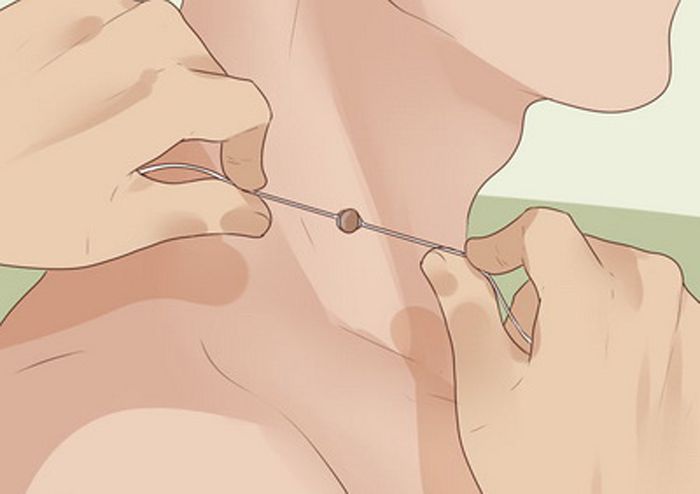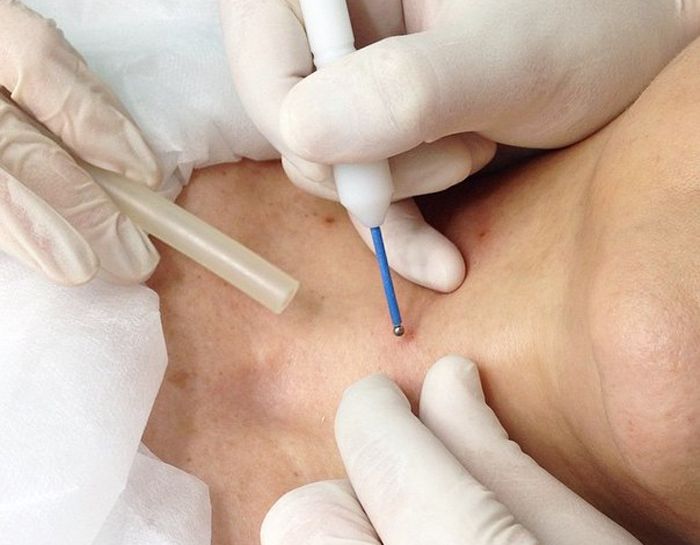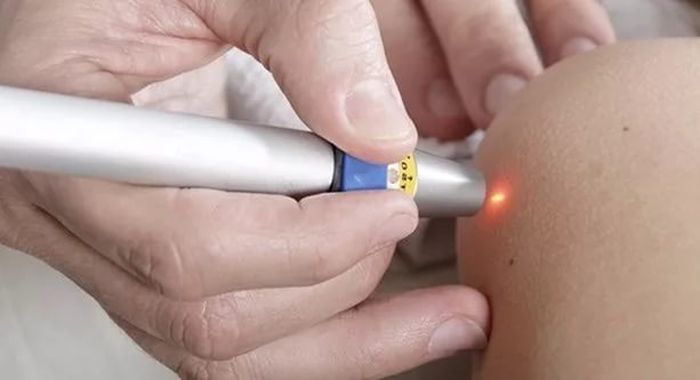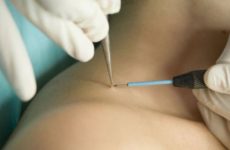The appearance of papillomas and warts on the body is not uncommon. In most cases, these formations do not cause discomfort, but sometimes they grow, and in addition to an aesthetic defect, they cause physical discomfort to their owners.
Then the question of whether they need to be removed does not arise – the formations are removed. But about whether it is necessary to remove papillomas , which do not cause discomfort and do not manifest themselves symptomatically, doctors have different opinions. Therefore, first you need to figure out what reasons provoked papillomatosis, and what character these formations have.

Содержание:
When is the best time to get rid of growths in summer or winter?
If papillomas are benign, do not cause aesthetic or physical discomfort, then many experts are inclined to believe that they do not need to be removed. However, areas of the skin that are subjected to friction or other physical impact must be cleaned of papilloma . If the formation is damaged, the risk of infection increases, and the risk of microorganism damage to surrounding tissues also increases, which will lead to an extensive inflammatory process.
So, you need to remove papillomas in the following cases:
- formations cause an aesthetic defect and rub against clothes;
- papillomas are prone to infection;
- papillomas are caused by oncogenic strains.
It is not worth removing youthful warts – as soon as the adolescent’s immunity gets stronger, they will disappear on their own. If the formations do not interfere with the person in any way, they can also not be removed, but to observe their development. If the immune system copes with the virus on its own, papillomas may disappear.
What happens if you tear it off yourself?
Most often, papillomas come off that are deformed, as well as those that are localized in the neck. The easiest way to pluck formations that are actively growing, because they are loosely connected to the surface of the skin.
How the papilloma was torn off (accidentally or intentionally) does not matter, the consequences of this can be quite serious. Papilloma is a viral formation, and viruses are cells, and they are living and self-organizing. This means that, having violated the integrity of the formation, a person releases a large number of viral agents that will spread over the surface of the skin and provoke new growth processes.

In addition, the following consequences are possible:
- With unprofessional removal of the skin growth, a bleeding wound opens, which, of course, will serve as a gateway for the penetration of various pathological microorganisms.
- An inflamed wound will be a source of inflammation in the tissues, and this will provoke a change in the size of the formation.
- The most serious and dangerous thing is that by disrupting a benign formation, you can start the process of degeneration into oncology.
- The papilloma virus is a very unusual virus, it is able to change the tissues of the body that infects.
Therefore, it is strictly forbidden to pluck the papilloma on purpose! But what if it happened by accident?
The following steps are required:
- Quickly treat the wound with any disinfectant – iodine , hydrogen peroxide, just alcohol and others.
- Isolate the wound from the environment – seal it with a plaster, bandage it with a sterile bandage, just wrap it with a clean cloth.
- Urgently go for a consultation with a doctor.
As a rule, immediately after the examination, the doctor sends the patient for an additional examination.
What is the best time of the year to get rid of a build-up?
It is undesirable to remove papillomas in the summer. At this time of the year, the sun is in its most active phase, and after the removal procedure, active sun rays will be strictly prohibited. Some believe that exposure to sunlight will provoke a malignant process – this is not true, but getting on young and still unprotected tissue, active sun can cause the threat of age spots. It is best to remove papilloma in late autumn, winter or early spring.
Some believe that success in the fight against papillomas is directly related to the lunar rhythm. Moreover, there is an opinion that if the wart is removed on the wrong day, the growth of formations may increase.
To believe in it or not – everyone decides for himself. We can only say that there is no scientific medical evidence for this, but astrologers say the opposite. They say that the initial days of each phase are considered dangerous. Important things should not be started at this time, and it is also recommended to be careful about your health, so people who are serious about astrological dates can take a closer look at the lunar calendar before removing the papilloma and choose the optimal date for the procedure.

As for scientific facts, it is undesirable to remove neoplasms during menstruation. This is due to the peculiarities of this period of women. Changes in hormonal levels can affect body functions. For example, the ability of blood to clot decreases. Therefore, it is better not to prescribe operations that involve bleeding during this period. In addition, on critical days, the woman’s immune system is weaker, which makes the female body more vulnerable to pathogenic flora.
It is not recommended to remove papillomas during childbearing and lactation. The removal procedure often requires anesthesia, and this can adversely affect the child.
Removal Methods
Dermatologists recommend starting to fight papillomas with the help of drug treatment. There is an extensive list of topical medications that can significantly reduce the size of neoplasms.
For example:
- Ferezol. This remedy must be applied strictly to the damaged area, while not touching healthy skin tissues. The maximum number of procedures is 5 times.
- Dermavit. Contraindications – papillomas in the armpits and mammary glands.
- Supercleaner. The tool is made on the basis of celandine juice, and its natural composition allows you to safely use this tool on the face, where the skin is more sensitive.
- Isoprinosine. This is a modern antiviral agent, which is also an immunomodulator. This is a tablet form, it is recommended to take 2 tablets after meals.
Methods for removing papilloma in the clinic:
- Surgical removal of papilloma is now rarely used. The procedure consists in excising the formation with a scalpel under local anesthesia. This method leaves behind scars.
- Electrocoagulation is a more popular method of getting rid of papilloma. Neoplasms are affected by an electric current, which leads to clotting of protein tissue. Large papillomas are removed under local anesthesia. The disadvantage of this procedure is the possibility of relapse and the risk of scarring.
- Laser destruction – removal of papilloma with a laser beam. In this case, there are no scars and scars, and the recovery period lasts no more than a week. Another plus is that there is no direct contact with the skin, which contributes to quick and easy healing.
- Cryotherapy – liquid nitrogen is used, which leads to freezing of the formation. Possible scarring.
- Radio wave removal of papilloma is the most modern method, which consists in the use of a special device that creates radio waves. Contraindication – malignant tumors.

Folk ways
Self-medication is always dangerous. It is not recommended to remove papillomas without consulting a doctor. Any wrong action can provoke the transformation of a benign formation into a malignant one. Less serious complications are also possible – bleeding, infection, and so on. Therefore, even folk remedies for papilloma removal can only be used under the close supervision of a doctor.
Most often, traditional healers recommend celandine to remove papilloma. To prepare the remedy, it is necessary to squeeze the juice from the plant, and then evaporate it to a thick consistency. The resulting agent must be lubricated with the formation until it disappears completely.
Since infection with the papillomavirus occurs in people with an insufficient immune system, it is recommended to use potato juice, echinacea, decoctions of lemon balm, plantain, rosehip, nettle, dandelion roots. These funds raise immunity well, and the body begins to fight the virus and its manifestations on its own.
You can also get rid of warts using non-herbal methods. For example, using boric acid, iodine, aspirin, alcohol. There is still a way – to apply cakes of flour and vinegar to the affected area.

Papilloma is removed using the following extracts:
- tea tree;
- echinacea;
- lemon oil;
- castor oil .
Lifestyle after papilloma removal.
After the removal procedure, you must adhere to the following recommendations:
- Immediately after removing the formation, the doctor will treat the wound with an antiseptic. This procedure must be repeated three times a day for 5 days.
- It is necessary to lubricate the wound with oil solutions that contain vitamins E and A. These vitamins will promote rapid tissue regeneration.
- Taking a bath after removal of neoplasms is not recommended for a couple of months, and when washing in the shower or washing, the formation must be sealed with a plaster.
- Within 2-3 weeks after the removal of the papilloma, you need to cover the damaged area from the sun’s rays.
- Solarium or any other ultraviolet radiation is prohibited.
- It is impossible to tear off the resulting crust; it is also not recommended to apply various creams and ointments to it, except for those prescribed by the doctor.
Wart removal cost
Of course, the cost of the papilloma removal procedure depends on the method of removal, as well as on the size of the formation.
Approximately:
- cryodestruction – from 100 to 300 rubles ;
- laser removal – from 600 to 1300 rubles ;
- removal by radio waves – from 300 to 1500 rubles ;
- electrocoagulation – from 200 to 700 rubles .
More precise information about prices should be obtained directly from the clinic.
Prevention
There is nothing difficult in the prevention of papilloma. It is recommended to avoid dampness as much as possible, carefully treat cuts and scratches (since the infection can enter the body in this way), take care of increasing immunity, and avoid stressful situations. In addition, you must use only your own items and personal hygiene products and not have sexual intercourse in casual contacts without personal protective equipment.
There is no cure for the papilloma virus itself, the fight against its manifestation is only at the level of removing neoplasms and increasing the body’s immune forces. Whether or not to remove papillomas is very individual and depends on a large number of factors; a good specialist can help you make the right decision in this matter.







